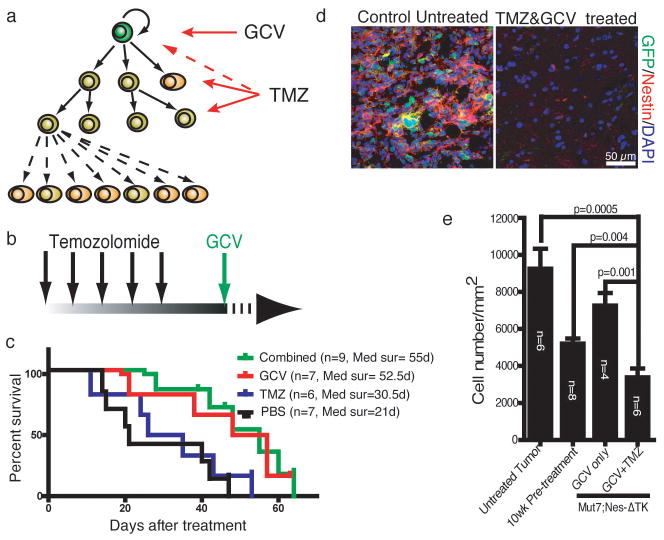Figure 4.
Combination treatment of Temozolomide (TMZ) and GCV inhibits glioma progression in cerebrum. a,b, Therapeutic schema targeting both CSCs and their proliferating progeny. Mut7;Nes-ΔTK mice were treated with TMZ for 5 days, followed two days after by GCV. c, Kaplan–Meier survival curve of Mut7;Nes-ΔTK mice with different treatments. GCV-treated (n=7; median survival=55 days) and combinationally-treated (n=9; median survival=52.5 days) Mut7;Nes-ΔTK mice had similar survival advantage over TMZ-treated (n=6; median survival=30.5 days) or PBS-treated (n=7; median survival=21 days) mice. P values determined using Log-rank test. d, GFP and Nestin double immunostaining of vestigial tumors in TMZ/GCV-treated Mut7;Nes-ΔTK mice (right panel) versus tumor in control (left panel) demonstrates depletion of CSCs as evidenced by lack of GFP expression. e, Maximal cell density in cortical tumors with different treatment regimens. Untreated Mut7 mice (n=6) were used as control. Tumor density of 10-week-old non-symptomatic Mut7 mice (pre-treatment) (n=8) was used as a reference starting point. Cell density was significantly lower in the combinationally-treated (TMZ+GCV) Mut7;Nes-ΔTK mice (n=6) compared to untreated tumors (p=0.0005), compared to tumors in “pre-treatment” mice (p=0.004), and compared to tumors from mice treated with GCV only (n=4) (Data are mean ± s.e.m.; p=0.001; P values determined using Student’s t-test.).

